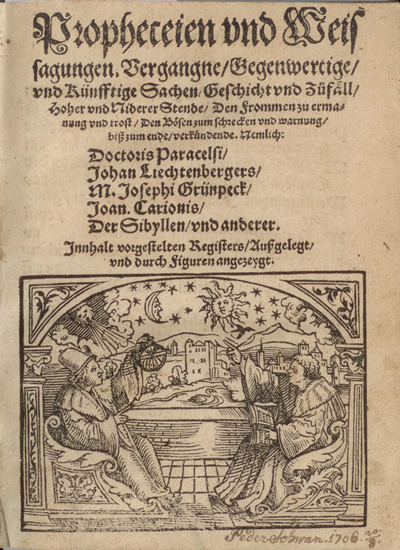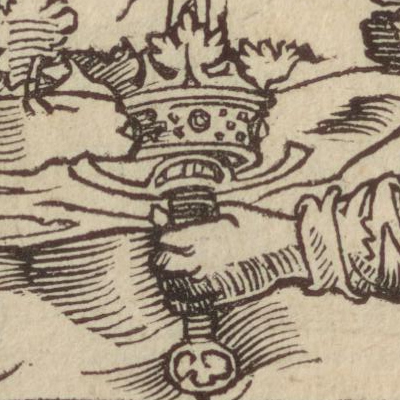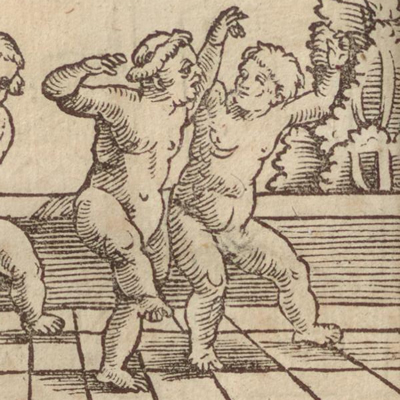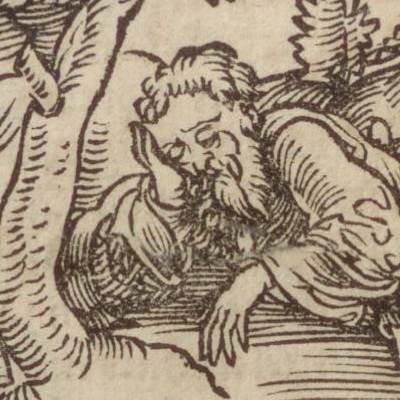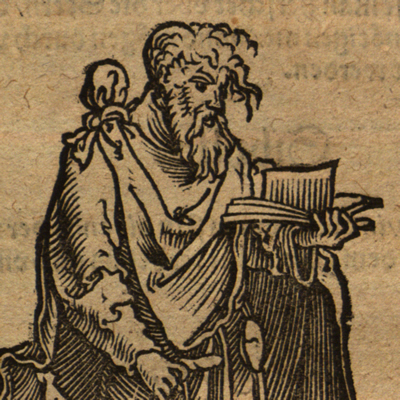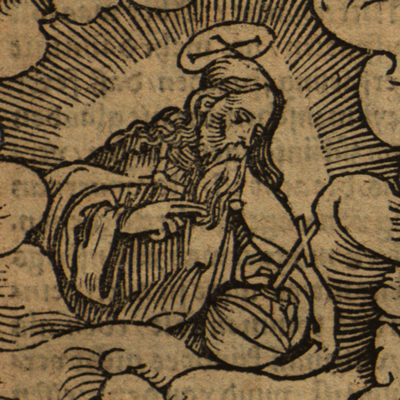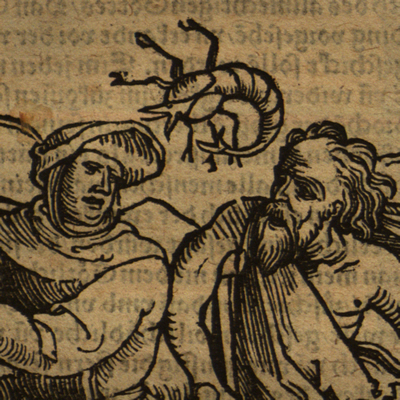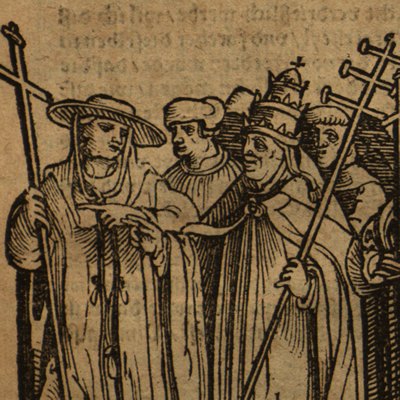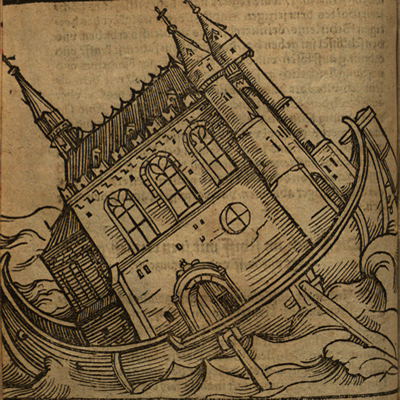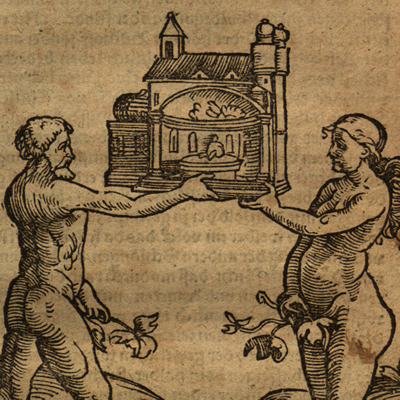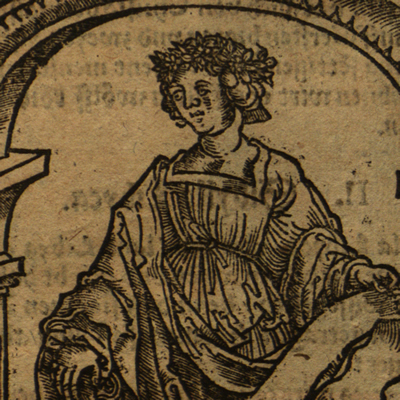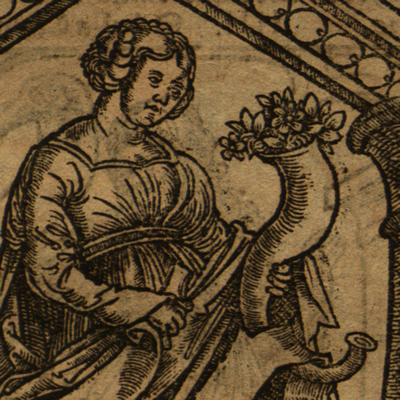The Prophetic Compilation of Christian Egenolff
One of the most significant prophetic compilations was the Propheceien und Weissagungen printed by Christian Egenolff in Frankfurt in the late 1540s. The Paracelsus Collection contains two copies of this work, one from 1549 and one from 1550. The woodcut illustration on the title page is particularly interesting. While one of the two figures holds a book, which could be a reference to the importance of the written prophetic tradition handed down from the Bible, both of them are also looking toward the heavens. This is likely a reference to the increasing importance of astrology in prognostication. While astrology was traditionally regarded with a certain level of suspicion because it attempted to discern the mysteries of God with reason rather than faith, during the early modern period it became an increasingly significant aspect of prophecy.
Egenolff’s compilation includes several prophecies, three of which are accompanied by woodcut illustrations. The first of these is Paracelsus’ Prophecy for the Next Twenty-four years. Paracelsus (1493-1541), who entered the world as Theophrastus Bombastus von Hohenheim, is one of the most fascinating figures of the early modern period. He supposedly earned his baccalaureate from the University of Vienna, and might have earned his medical degree from the University of Ferrara, although whether or not he was actually awarded the title “Doctor of Medicine” is unclear. What is clear, however, is that he cared little for the liberal arts curriculum taught at the universities, and had no patience for the new medical humanism that lionized classical physicians. He believed that nature, not textbooks, was the best source of medical knowledge, and spent several years wandering everywhere from Spain to Russia, speaking to folk healers and learning local remedies.
Paracelsus was unlucky in publishing, and only two of his medical works were printed during his own lifetime. He had somewhat better luck with his prophetic works. In addition to several short annual practicas, he authored the longer Prophecy for the Next Twenty-Four Years, which was printed in German and Latin in 1536 by the Augsburg printer Heinrich Steiner. The Prophecy was Paracelsus’ most ambitious venture into prophecy. Rather than providing only a short glimpse at the coming year, the Prophecy contained Paracelsus’ predictions for Christian Europe from the time of its publication until 1560. The text was accompanied by 32 original woodcut illustrations, as well as a woodcut title page. The title page depicts a scholar consulting the heavens, similar to what is depicted on the title page of Egenolff’s compilation, and indicates that, like Lichtenberger before him, Paracelsus believed strongly in astrology’s importance to prophecy.
The most striking feature of the Prophecy is undoubtedly the illustrations. The exact origin of the images is unknown, although they might have been designed and commissioned by Paracelsus himself. They feature the usual religious and political symbolic imagery that could easily be applied to the turbulent events of the 16th century, and are also distinctly eschatological in tone. The images imply that there would be a time of increasing unrest, but that by around 1543 the elect would be gathered together in preparation for the final days, which would occur around 1560 - although Paracelsus was sure to include a disclaimer that it was impossible to know with certainty whether these events would play out over the course of a human lifetime.
The second illustrated prophecy in Egenolff’s compilation is the Prognostication of Johannes Lichtenberger (c. 1440 – 1503). This was one of the most well-known early modern prophecies. It was first published in Latin in 1488 by Heinrich Knoblochtzer in Heidelberg, and a German edition followed in 1490. It was reprinted multiple times throughout the 16th and 17th centuries, either in its entirety or in abbreviated form. Although Lichtenberger’s content was unoriginal and drew copiously from already established prophetic authorities including Joachim of Fiore and Birgitta of Sweden, it was distinguished by its willingness to incorporate astrological prediction, especially in relation to the conjunction of Saturn and Jupiter in 1484.
Lichtenberger’s work was of considerable interest to 16th century intellectuals. In 1527 Martin Luther supplied the commentary for an edition of the Prognostication. Although Luther was willing to concur with Lichtenberger on some points, he still warned that astrology lacked a spiritual component and was only useful for examining natural events. Lichtenberger’s work was also of great interest to Paracelsus, who wrote his own commentary on it in the late 1520s.
The final illustrated prophecy that appears in Propheceien und Weissagungen is a version of the Prophecy of the Twelve Sibyls. It begins with a story in which a mysterious old woman – some say it was the Cumaean sibyl - came to the Roman King Tarquinius Superbus and offered him nine books of prophecy. The king refused to pay her price, and she burned three of the books. The next day she offered him the six remaining books for her original price. The king refused once more, and she burned another three books in anger. The king finally bought the three remaining books for the cost of the original nine, and the woman departed, never to be seen again.
After this initial story, the prophecy contains woodcut images of the individual sibyls accompanied by a description of their appearance and the content of their prophecies, which mainly revolve around the coming of Christ. The number of sibyls has fluctuated throughout history. In Greco-Roman tradition there were ten, while the Christian tradition increased this to twelve, to mirror the twelve prophets. In the version included by Egenolff, the Queen of Sheba is shown as the thirteenth sibyl.
